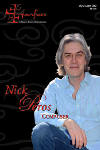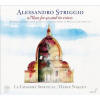Texte paru dans: / Appeared in:

Fanfare Magazine 35:6 (07-08/2012)
Pour
s'abonner / Subscription information
Les abonnés à Fanfare Magazine ont accès aux archives du
magazine sur internet.
Subscribers to Fanfare Magazine have access to the archives of the magazine
on the net.
Glossa
GCDSA921623

8424562216235
Consultez toutes les évaluations recensées pour ce cd
~~~~ Reach all the evaluations located for this CD
As if to reinforce the point that I made in reviewing the recent premiere version of this Mass (Fanfare 35:1), that the surround sound should have been available on the main disc, not just on a supplementary DVD, the program on this SACD opens with a chant antiphon, Beata viscera, sung in procession coming gradually from the rear speakers to the front. The engineers take full advantage of the resonant acoustics of the Lebanese church in Paris (a longtime favorite recording venue), and the multivoice polyphonic works that follow only build on the initial impression. This is not the first time that a premiere recording of an unfamiliar work made a favorable impression, only to yield to a competing version that showed how much better the work can sound. The reverberant acoustics, well controlled by the engineers, contribute mightily to a performance that in itself is grand and glorious, and the forward propulsion that Hervé Niquet brings to the performance is stunning.
Niquet’s performance is grander indeed than Hollingworth’s, but the difference in tempos is primarily in the Gloria and Credo, which are somewhat broader in Niquet’s reading, the other movements being nearly the same in both versions. Since there are only two settings of Agnus Dei, Niquet fills in the middle invocation in chant. Aware of the need to give a breather during the course of the Mass, Niquet uses several Mass Propers of Striggio’s older contemporary in Florence, Francesco Corteccia, to celebrate the feast of St. John the Baptist in the cathedral of Florence, the city that venerated him as its patron saint (hence the great significance of the cathedral’s baptistry). An introit leads into the Kyrie, then an alleluia is inserted before the Credo, and a communion follows the Agnus Dei before we hear Striggio’s motet that is a contrafact of the 40-voice madrigal that gave the Mass its cantus firmus. Orazio Benevoli, another composer of the monumental Baroque style, not born until after the death of Striggio, is heard at the offertory (a rather oddly chosen Magnificat) and at the beginning of the program (two psalms).
Another bit of one-upmanship can be read in the notes. Acknowledging that Davitt Moroney’s article in the Journal of AMS was the means of bringing the Mass to wide attention (and leading to Hollingworth’s recording, to be sure), he points out that Dominique Visse had already found the work in the Bibliothèque nationale in 1978 and made the transcription that Niquet uses for this recording. It was made almost a year after the first one, but it was worth waiting for. Niquet arranges his forces somewhat differently than Hollingworth. Niquet has choirs 1 and 5 unaccompanied; choir 2 is doubled by an organ and a regal; choir 3 is accompanied by two wind groups, brass and reed; choir 4 is doubled by a harpsichord and a spinet. The purpose is to differentiate the five choirs. The different layouts are a matter of judgment, for the contemporary accounts of performances in Munich and Paris make no mention of instruments. If you already have the first recording, you must hear this for comparison, and admittedly Hollingworth includes not just the related motet by Striggio but also the Tallis motet that originally focused attention on Striggio. Otherwise, this is a clear choice for the stunning sound and interpretation.
Cliquez l'un ou l'autre
bouton pour découvrir bien d'autres critiques de CD
Click either button for many other reviews


